With its coastlines on Lake Michigan and Lake Superior, plus 15,000 smaller lakes, Wisconsin is a big attraction to lots of birds, including woodpeckers.
Bird lovers have many different areas known as “migrant traps” that they can watch for woodpeckers in, including Horicon and Alma parks, which feature waterways, hiking trails, and other great places to spot your favorite species.
The combination of wetlands, marshlands, and forested areas attracts all kinds of woodpeckers to Wisconsin, and there is even a Great Wisconsin Birding and Nature Trail that sweeps across the state to make your birdwatching adventures easier.
Most woodpecker species make Wisconsin their home year-round, which makes birdwatching even easier. Explore the nine species that you might catch a glimpse of.
Here is the list of woodpeckers in Wisconsin:
- American Three-Toed Woodpecker
- Black-Backed Woodpecker
- Downy Woodpecker
- Hairy Woodpecker
- Northern Flicker
- Red-Bellied Sapsucker
- Red-Headed Woodpecker
- Yellow-Bellied Sapsucker
- Pileated Woodpecker
9 Types of Woodpeckers in Wisconsin
1. American Three-Toed Woodpecker

Scientific name: Picoides dorsalis
Size: 8.3-9.1 inches
Weight: 1.6-2.4 ounces
Wingspan: 14.6-15.3 inches
This woodpecker primarily makes Canada its home, but you will rarely see it head down to northern states such as Maine, Michigan, and Wisconsin. It also lives year-round in western parts of the country, including Idaho, Utah, Arizona, Colorado, and Wyoming.
This bird likes to feed in burned-out areas and forests where fires and beetles have killed off the trees. It hunts for insects, pulling and stripping away bark until it finds those juicy beetles.
This bird only has three toes, as the name suggests, but you’ll most easily be able to identify it by its coloring. It’s primarily black, but it has white barring on its sides and back, and the chest is white. The male has a bright yellow crown.
2. Black-Backed Woodpecker
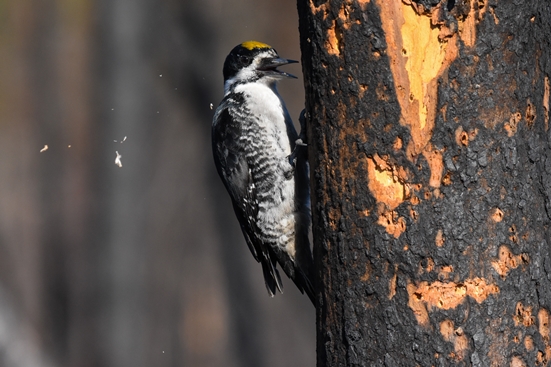
Scientific name: Picoides arcticus
Size: 9.1 inches
Weight: 2.1-3.1 ounces
Wingspan: 15.8-16.5 inches
Many woodpeckers in North America are some pattern of black and white, often with a red patch on the head. This woodpecker stands out because of its solid black back and white chest. It has a black face with a distinct white stripe. The male has a small yellow crown.
Making its home in burned-out forests across all of Canada and the western US, this woodpecker also has a few colonies in areas like northern Michigan, Wisconsin, New Hampshire, and Maine.
Its black coloring helps it blend in with the charred trees that it hunts on. It eats beetle larvae and will hang out in recently-burned areas for several years before moving onto more newly burned areas.
3. Downy Woodpecker
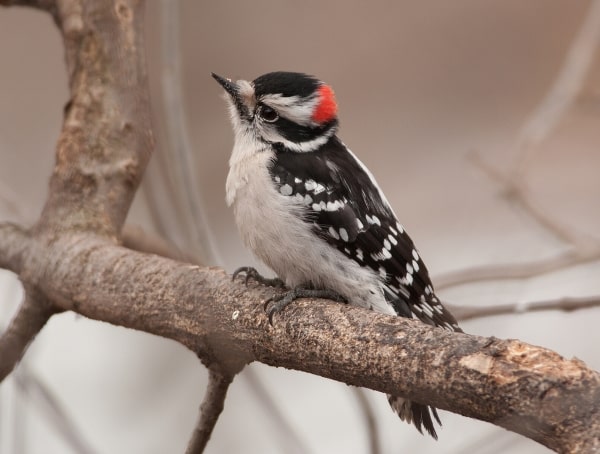
Scientific name: Dryobates pubescens
Size: 7 inches long
Weight: 0.75-0.99 ounces
Wingspan: 10-12 inches
The downy woodpecker is the smallest woodpecker in Wisconsin (and the rest of the US) and is extremely common across North America. It doesn’t migrate but instead stays in its home year-round, which means you might be able to spot it even during the harsh winters in Wisconsin.
You can find this itty-bitty woodpecker pretty much anywhere. It lives in rural areas, cities, suburban yards, and wilderness areas. It doesn’t mind the desert or a nice wooded area.
During the wintertime, they flock with other birds such as chickadees and nuthatches for safety and to find food. They build their nests in the cavity of trees where they live and raise their young. While they may change their habitat range during the seasons, they don’t travel too far.
Downy woodpeckers are black and white, with distinctly spotted wings and a white chest. Adult males have a bright red cap on the back of their heads, which makes them easy to identify from females.
If you want to watch these birds (and many other woodpeckers) in the wild, place a suet feeder in your yard. They love them and will come to hang out for a bit so that you can observe their antics.
Because of their small size, they can land on small stems of plants to hunt for food. They’re also small enough that they often make nests in the wood siding of homes, much to the dismay of homeowners.
4. Hairy Woodpecker

Scientific name: Picoides villosus
Size: 7.5 inches
Weight: 1.4-3.4 ounces
Wingspan: 13-16 inches
Hairy woodpeckers look a lot like downy woodpeckers, but you can tell them apart because hairy woodpeckers are bigger and have a longer bill. Their bill is almost the same length as their head. They’re black and white all over. You can tell the genders apart because the adult males have a little red spot on the back of their heads.
These pretty woodpeckers aren’t as common in cities as their cousin, the downy woodpecker. However, you can still see these woodpeckers in parks, suburban areas, cemeteries, and other quiet wooded or open areas in Wisconsin. They also visit suet feeders in suburban backyards.
Like their cousin the downy woodpecker, hairy woodpeckers don’t migrate during the cold weather and stay put all year. They make their nests in the cavities of dead trees. Research published in The Journal of Wildlife Management found that they prefer forests that have been burned recently.
Populations have been declining in the past few decades because they’re losing their habitat. They also face pressure from invasive birds like European starlings, which steal their nesting spots.
5. Northern Flicker
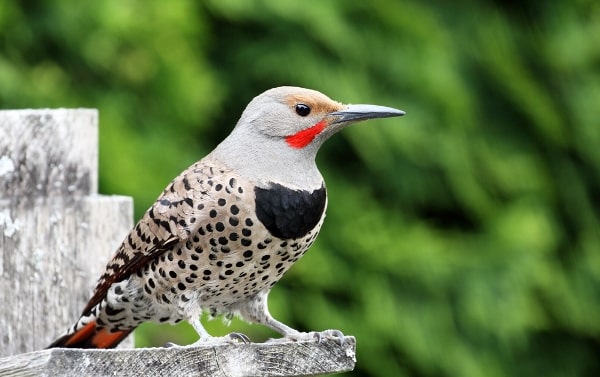
Scientific name: Colaptes auratus
Size: 11-12 inches
Weight: 4-6.5 ounces
Wingspan: 16.5-20 inches
The distinctive northern flicker woodpecker lives in open habitats near trees, as well as in parks and cemeteries across Wisconsin. They are a frequent visitor to suet feeders in suburban and urban yards. Unlike some woodpeckers in Wisconsin, they like to hunt around on the ground rather than in the trees.
The males, females, and juveniles vary in appearance. They’re brown in color overall, with black spots. The underside of the wings and tails are yellow in the eastern half of the US and red in the western half of the US.
Some have a red or black stripe on their cheeks, and many of them have large, black crescents on their chest. Others have red marks on the back of the head. Some have a slightly gray head.
In the spring, the calls of Northern flickers can be heard for long distances. It’s a distinct sound, and once you know how to identify their calls and drumming, it’s easy to tell when they’re around.
They primarily eat ants, but they’ll also dine on insects such as caterpillars, beetles, and termites. There are also instances of them catching young bats as they leave the nest. You can tempt them to visit your home by offering a suet feeder in the yard.
Flickers who live in Alaska and Canada will migrate to areas that have higher temperatures during the winter, but these woodpeckers may stick around Wisconsin all year round.
Studies show that Northern Flickers can lose their nests to invaders like European starlings.
6. Red-bellied Woodpecker
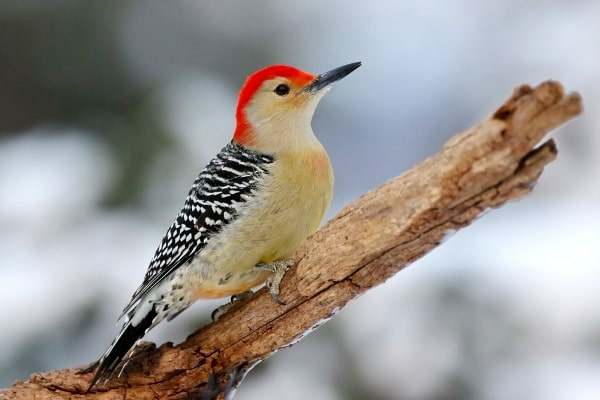
Scientific name: Melanerpes carolinus
Size: 9.5 inches
Weight: 2.0-3.2 ounces
Wingspan: 13.0-16.5 inches
You’d probably expect these woodpeckers to have bright red bellies, but that’s not the case. Their bellies are typically pale, creamy white. Their back and wing feathers are black and white striped, and the females have a red nape. The males have a red nape and crown.
So where did the name “red-bellied” come from? The woodpeckers actually have red feathers on their bellies, but they are usually covered by white feathers so you can’t see them.
These active birds live all across the Eastern United States, including Wisconsin, and you can spot them in the air as they fly by their undulating flight pattern.
Look for them in oak and hickory trees, where they like to feed and nest. They’ll also visit suet feeders now and then.
7. Red-headed Woodpecker
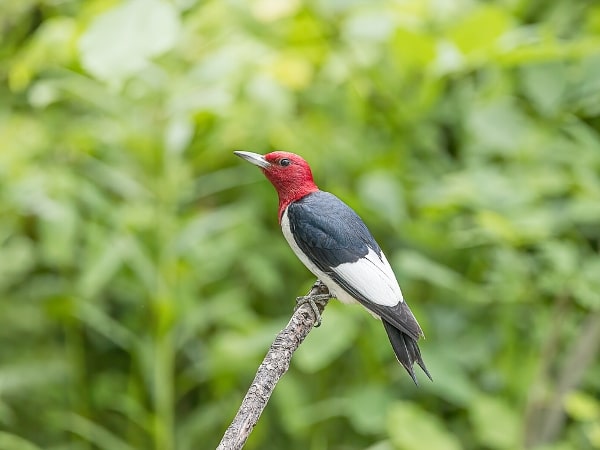
Scientific name: Melanerpes erythrocephalus
Size: 7.5-9.1 inches
Weight: 2.0-3.2 ounces
Wingspan: 16.5 inches
Red-headed woodpeckers are striking birds. They have solid black wings with a big white patch, and white bodies. To top it off, a deep, dark red head and neck that is so vibrant it looks like velvet.
The juveniles are brownish-black with white spots on the wings and dull red cheeks.
They don’t cross the Rocky Mountains, but they can be found in all parts east, from Canada to Florida. These woodpeckers breed in northern Wisconsin, and winter in the southern part of the state.
It’s one of the few woodpeckers out there who like to store food for the winter. They stuff seeds and nuts in bark or holes in trees. They have even been known to stuff food under shingles.
They also hunt their prey, snatching insects out of the air. That’s uncommon behavior for woodpeckers and makes for an interesting show if you can catch it.
8. Yellow-bellied Sapsucker
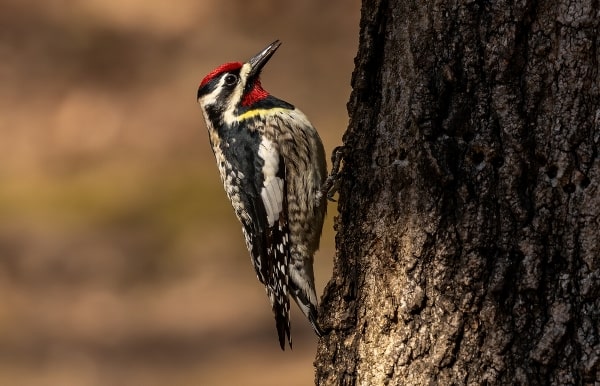
Scientific name: Sphyrapicus varius
Size: 7.1-8.7 inches
Weight: 1.5-1.9 ounces
Wingspan: 13.4-15.8 inches
The beautiful yellow-bellied sapsucker lives in the eastern half of the US and it will head to the southern part of the country in the winter and will stay in states like Wisconsin during the warmer months
These birds are mostly black and white, with white bellies, and black and white barred wings and back. You can tell the difference between males and females because the throat of the male is bright red. Females, on the other hand, have a white throat. Both the females and males have red foreheads.
The females have a faint yellow coloring to their bellies, but it can be so indistinct that you might not be able to identify it.
The birds drill little holes with their beaks and then they wait for the sweet sap to emerge from the tree. They lick this up, along with any insects that crawl along and get themselves stuck in the sap.
You might see them hanging out at your backyard suet feeder, but they mostly stick to forested areas.
9. Pileated Woodpecker
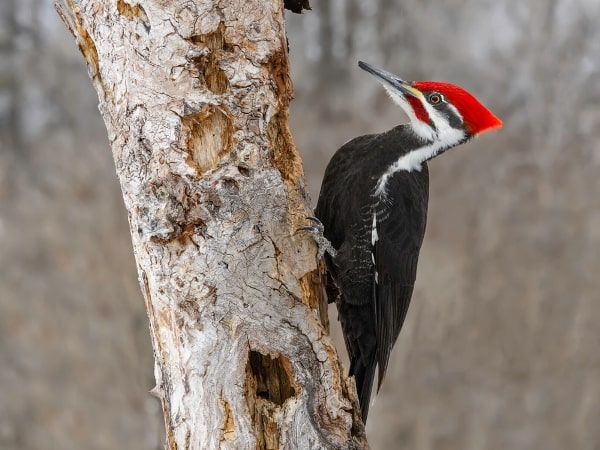
Scientific name: Dryocopus pileatus
Size: 16-19 inches
Weight: 9-14 ounces
Wingspan: 30 inches
The pileated woodpecker lives in Wisconsin year-round. They often make their nests in utility poles or high up in tall trees in deadwood. Their favorite snack is carpenter ants, which they will dig rectangular holes deep into the wood to find.
They’ll also eat nuts and berries and have even been known to chomp on poison ivy berries. You may occasionally see them foraging on the ground for food, but they usually stick to the trees.
These striking birds are mostly black and white, but they stand out because of their bright red crest. The males also have a red stripe on the side of their faces. These are large birds, about the same size as a crow.
The pileated woodpecker doesn’t migrate. It stays in the same area year after year. They will, however, move their nest if the eggs fall out of it.
The cartoon bird Woody Woodpecker was likely based on this species.
Also Read: Owls in Wisconsin Hummingbirds in Wisconsin
